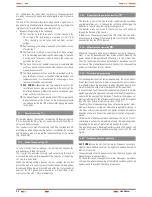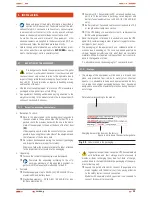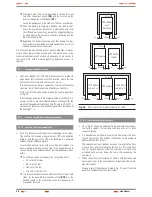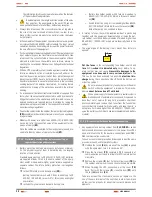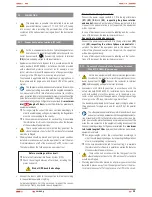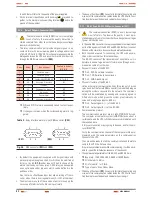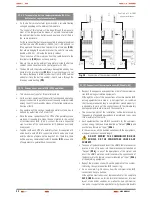
46
6. OPERATING.
• During the description of this section, it is detailed the procedure
to follow to get the different functionalities, considering a system
of
«n»
equipments connected in parallel.
If in your case, it is available
only one
UPS from
SLC CUBE3+
,
series, proceed in the same order, but simplifying the operating
for a
single
unit.
•
As it has been stated before, it is advisable to have an
external manual bypass panel board equipped with
input, output, static bypass (
CUBE3+ B
version only) and
manual bypass protections, in single installations.
For parallel systems up to two units it is very
is very advis-
able
having a switchgear panel board and for systems with
3 or 4 equipments,
it is essential
. Switches of the panel
board have to allow isolating a UPS from the system against
any wrong operating and feeding the loads with the rest
ones, either during the preventive maintenance period or
the reparation of itself.
• Therefore it has been considered appropriate and naturally, to
contemplate in the instructions of the equipment, the operating
of a system with
«n»
equipments connected in parallel with
their respective external manual bypass panel board as it is
shown in the
«
Recommended installation
»
documentation in-
cluded in the CD.
This panel board allows isolating each equipment individually in
case of fault and removing it without any difficulty for its repa-
ration or replacement. Also, the included manual bypass switch
makes easier the preventive maintenance tasks or intervention
over the complete system, supplying the voltage to the loads
directly from mains, on the
«
bypass
»
mode operating, mean-
while the input voltage is available.
In those installations without the external manual bypass panel
board, omit the actions and steps that involve the manoeuvring
of their switches.
6.1.
PRELIMINARY CONSIDERATIONS.
• It is very important to always operate in the established order
in the described instructions in the next sections, by respecting
the sequence of the switches in relation to its function.
So, i.e. in parallel system based on four equipments, when it is
stated to turn on the
«
Input
»
mechanisms, the order of turning
on them will not matter, but any other switch with different
function as it could be
«
Output
»
switch will not be turned on,
till is stated.
• Unlike other UPS structures, where the
«
Master
»
and
«
Slave
»
equipments are preset strictly from factory, conditioning the
order of start up and shutdown, the new
SLC CUBE3+
series
is managed by a more flexible hierarchy according to the oper-
ating mode that it is.
6.2.
UPS OR SYSTEM START UP.
6.2.1. Controls before starting up.
• Make sure that all the connections have been made correctly
and are sufficiently tight, respecting the labelling of the equip-
ment and instructions of section «5.- Installation and connection
of the unit»
• Check that the UPS or each UPS switches and the batteries
cabinet or cabinets, as well as the switchgear panel board are
turned (position «Off»).
• Be sure that all the loads are turned «Off».
6.2.3. Start up procedure.
6.2.3.1. First start up procedure.
• When the equipment is started up the first time, the installation
menu of the control panel is activated automatically, which is
shown in English by default. By means if itself, the parameters
of the unit like language, date, nominal voltage and frequency are
defined.
The preset language is «English» by default.
•
For parallel systems, repeat the steps for each one of
them that it makes up, being able to do it in all of them
at the same time or chronologically one by one.
• Supply input voltage to the switchgear panel board.
• Turn «On» the input switch or switches of the panel board.
• Turn «On» the UPS input switch
(Q1a)
or from each equipment
that the systems is make up. The following message will be
displayed for a few seconds:
INSTALLATION
MENU
and the acoustic alarm will beep every 5 sec. Next the following
message will be displayed in the LCD panel:
LANGUAGE
AAAAAA
... where AAAAAA corresponds to the language of the menus
displayed in the LCD panel. The available languages are:
Spanish, English, French, German, Turkish and Russian.
By means of the keys
(
)
and
(
)
, move till selecting the lan-
guage and validate with
(ENT)
. Since this moment, the screens
will be displayed in the set language (in this case English).
The screen to set the time (hour, minutes, seconds) and date
(day of the week, day of the month, month and year) will be
displayed.
Clock: HH:MM:SS
Date: WKD DD/MM/YYYY
USER MANUAL

